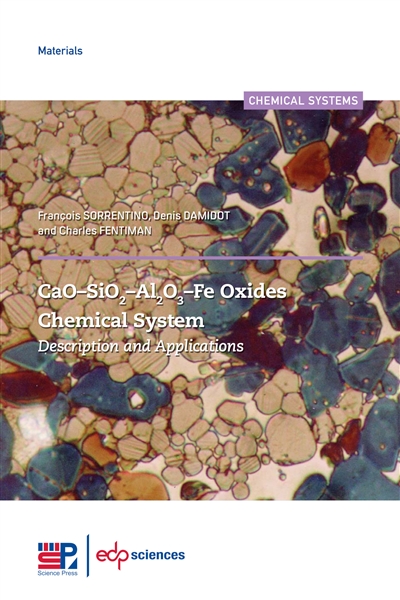CaO-SiO2-Al2O3-Fe
Oxides Chemical System
Description and Applications
François Sorrentino, Denis Damidot and Charles Fentiman
Edp sciences
PrefaceIII
Part I - Descriptions
Chapter 1
One-Component Chemical Systems : CaO, SiO2, Al2O3 and Fe Oxides
3
1.1 CaO3
1.1.1 Introduction3
1.1.2 Mineralogy, Structure and Stability3
1.1.3 Properties and Applications4
1.2 SiO25
1.2.1 Introduction5
1.2.2 Mineralogy5
1.2.3 Structure and Stability6
1.2.4 Properties and Applications6
1.3 Al2O37
1.3.1 Introduction7
1.3.2 Mineralogy8
1.3.3 Structure and Stability8
1.3.4 Properties and Applications9
1.4 Fe Oxides10
1.4.1 Introduction10
1.4.2 Mineralogy11
1.4.3 Structure and Stability11
1.4.4 Synthesis14
1.4.5 Properties and Applications14
Chapter 2
Binary Chemical Systems
17
2.1 CaO-SiO2 System17
2.1.1 Introduction17
2.1.2 Mineralogy17
2.1.3 Structure, Polymorphism and Solid Solution18
2.1.4 Stability and Phase Diagram of CaO-SiO2 System25
2.1.5 Synthesis of Calcium Silicates27
2.2 Al2O3-SiO2 System33
2.2.1 Introduction33
2.2.2 Mineralogy33
2.2.3 Structure, Polymorphism and Solid Solutions33
2.2.4 Stability and Phase Diagram37
2.2.5 Synthesis of Alumino-Silicates41
2.3 Al2O3-Fe Oxides System44
2.3.1 Introduction44
2.3.2 Mineralogy44
2.3.3 Structure, Polymorphism and Solid Solution44
2.3.4 Stability and Phase Diagram45
2.3.5 Synthesis of Iron Aluminates48
2.4 CaO-Al2O3 System48
2.4.1 Introduction48
2.4.2 Mineralogy49
2.4.3 Structure, Polymorphism and Solid Solution49
2.4.4 Stability and Phase Diagram55
2.4.5 Synthesis of Calcium Aluminates57
2.5 SiO2-Fe Oxides System62
2.5.1 Introduction62
2.5.2 Mineralogy62
2.5.3 Structure, Polymorphism and Solid Solution63
2.5.4 Liquid FeO-Fe2O3-SiO266
2.5.5 Stability and Phase Diagram of the FeO-Fe2O3-SiO2 System67
2.5.6 Synthesis of Iron Silicates71
2.6 CaO-Fe Oxides System72
2.6.1 Introduction72
2.6.2 Mineralogy72
2.6.3 Structure, Polymorphism and Solid-Solutions72
2.6.4 Stability and Phase Diagram75
2.6.5 Synthesis of Calcium Ferrite81
Chapter 3
Ternary Chemical Systems
83
3.1 General Introduction83
3.2 CaO-Al2O3-SiO2 System83
3.2.1 Ternary Constituents of the CaO-Al2O3-SiO2 System83
3.2.2 Mineralogy84
3.2.3 Structure and Solid Solutions85
3.2.4 Stability and Phases Diagrams (At One Atmosphere)90
3.2.5 Compounds Obtained in Special Conditions97
3.2.6 Stability Relative to Temperature or Pressure and Both98
3.2.7 Thermodynamic Models99
3.2.8 Synthesis of Calcium Silicoaluminate101
3.3 Al2O3-SiO2-Fe Oxides103
3.3.1 Introduction103
3.3.2 Mineralogy103
3.3.3 Structure and Solid Solution103
3.3.4 Stability and Phase Diagram104
3.3.5 Synthesis108
3.4 CaO-SiO2-Fe Oxides109
3.4.1 Introduction109
3.4.2 Mineralogy109
3.4.3 Structure and Solid Solution110
3.4.4 Stability and Phase Diagrams in Air112
3.4.5 Stablity and Phase Diagram in the CaO-SiO2-FeO System117
3.4.6 CaO-SiO2-FeOx System at Various Oxygen Pressures126
3.4.7 Model131
3.4.8 Preparation and Synthesis132
3.5 CaO-Al2O3-Fe Oxides134
3.5.1 Introduction134
3.5.2 Mineralogy134
3.5.3 Structure and Solid Solutions135
3.5.4 Stability and Phase Diagrams140
3.5.5 Liquidus in Reducing Atmosphere143
3.5.6 Model of the System145
3.5.7 Formation and Synthesis145
Chapter 4
Quaternary Chemical Systems
147
4.1 Introduction147
4.1.1 Principle of Phase Equilibrium in a Quaternary System147
4.2 CaO-SiO2-Al2O3-Fe2O3 System in Air152
4.2.1 Quaternary Constituents of the CaO-SiO2-Al2O3-Fe Oxides System152
4.2.2 Mineralogy153
4.2.3 Mineralogy Structure Stability158
4.2.4 Formation and Synthesis173
4.3 CaO-Al2O3-SiO2-FeO System173
4.3.1 Introduction173
4.3.2 Ternary Systems Located Within the CaO, Al2O3, SiO2, FeO Tetrahedron173
4.3.3 Binary Systems181
4.3.4 Crystallized Solids182
4.3.5 Univariant Lines and Quaternary Invariant Points182
4.3.6 2CaO-SiO2-CaO SiO2-Gehlenite-FeO Quaternary System183
Chapter 5
Quinary Chemical Systems
189
5.1 Introduction - Presentation of Quinary Data189
5.2 CaO-SiO2-Al2O3-FeO-Fe2O3 System189
5.2.1 Stability and Phase Diagrams189
5.2.2 Conclusions192
References of Part I193
Part II - Applications
Chapter 6
Applications to Hydraulic Binders
211
6.1 General Introduction211
6.2 Portland Cements (PC)212
6.2.1 Characteristics212
6.2.2 PC Applications220
6.2.3 Conclusions - Prediction of the Properties226
6.3 Calcium Aluminate Cements (CAC)227
6.3.1 CAC Characteristics227
6.3.2 CAC Applications234
6.4 Special Cements237
6.4.1 Fast-Setting Cements237
6.4.2 Geopolymers243
6.4.3 Oil Well Gements246
6.4.4 Expansive Cement251
6.4.5 Dental Cements253
6.4.6 Glass Cements259
Chapter 7
Application to Metal Refining
261
7.1 General Introduction261
7.2 Slags from Iron and Steel Industry261
7.2.1 Blast Furnace Slags (BFS)261
7.2.2 Converter Slags (Basic Oxygen Process or LD processing)266
7.2.3 EAF Slags : High Carbon Steel269
7.2.4 Ladle Slag (Secondary Metallurgy) - Stainless - High Alloy Steel Production269
7.2.5 Refining Under Reducing Slag270
7.3 Formation and Properties of Liquid Slags271
7.4 Slags from Non Ferrous Industry272
7.4.1 Copper Slag272
7.4.2 Silico-Manganese Slag272
Chapter 8
Application to Refractory Materials
275
8.1 Introduction275
8.2 Raw Materials Based on Al2O3 and SiO2276
8.2.1 Natural Raw Materials276
8.2.2 Synthetic Raw Material277
8.3 Applying Refractory Materials278
8.3.1 Brick and Monolithic Refractories278
8.3.2 Refractory Cement and Mortar281
8.4 Refractories Consuming Industry286
8.4.1 Iron and Steel Industry286
8.4.2 Non-Ferrous Metal Industry287
8.4.3 Cement Industry287
8.4.4 Whiteware, Traditional Ceramic Industry288
8.4.5 High-Tech Ceramic Industry288
8.4.6 Glass Industry288
Chapter 9
Application of the Glassy Products
291
9.1 Introduction291
9.2 Structure of Glass292
9.3 Classification of Glass Products Containing CaO, Al2O3, SiO2 and Fe Oxides293
9.4 Products, Chemistry and Process294
9.4.1 High Sihca Glass - Vycor Glass294
9.4.2 Soda-Lime Glass295
9.4.3 Sodium Borosilicate - Glass Fibres295
9.4.4 Aluminosilicate Glass297
9.4.5 Special Applications299
Chapter 10
Application of Ceramic Products
303
10.1 Introduction to Ceramics303
10.2 Structure of Ceramics303
10.2.1 Processing of Manufacture303
10.2.2 Shaping304
10.2.3 Physico-Chemical Changes During Firing305
10.3 Classification of Ceramic Products Containing CaO, SiO2, Al2O3 and Fe Oxides305
10.3.1 Introduction305
10.3.2 Traditional Ceramics305
10.3.3 Ceramics in the Construction Sector Ceramics312
10.3.4 High Technology Ceramics313
Chapter 11
Application as Fillers
315
11.1 General Introduction315
11.2 Mono-Component317
11.2.1 Calcium Oxide317
11.2.2 SiO2318
11.2.3 Alumina319
11.2.4 Fe oxides320
11.3 Multi-Components By-Products from Industrial Process321
11.3.1 Slags321
11.3.2 Fly Ashes324
11.3.3 Red Mud (KUR 1997)326
11.3.4 Cement Kiln Dust (CKD)327
11.4 Multi-Components from Natural Origin328
11.4.1 Natural Pozzolans328
11.4.2 Metakaolin330
11.4.3 Rice Husk Ashes (RHA)331
11.4.4 Wollastonite332
References of Part II335

